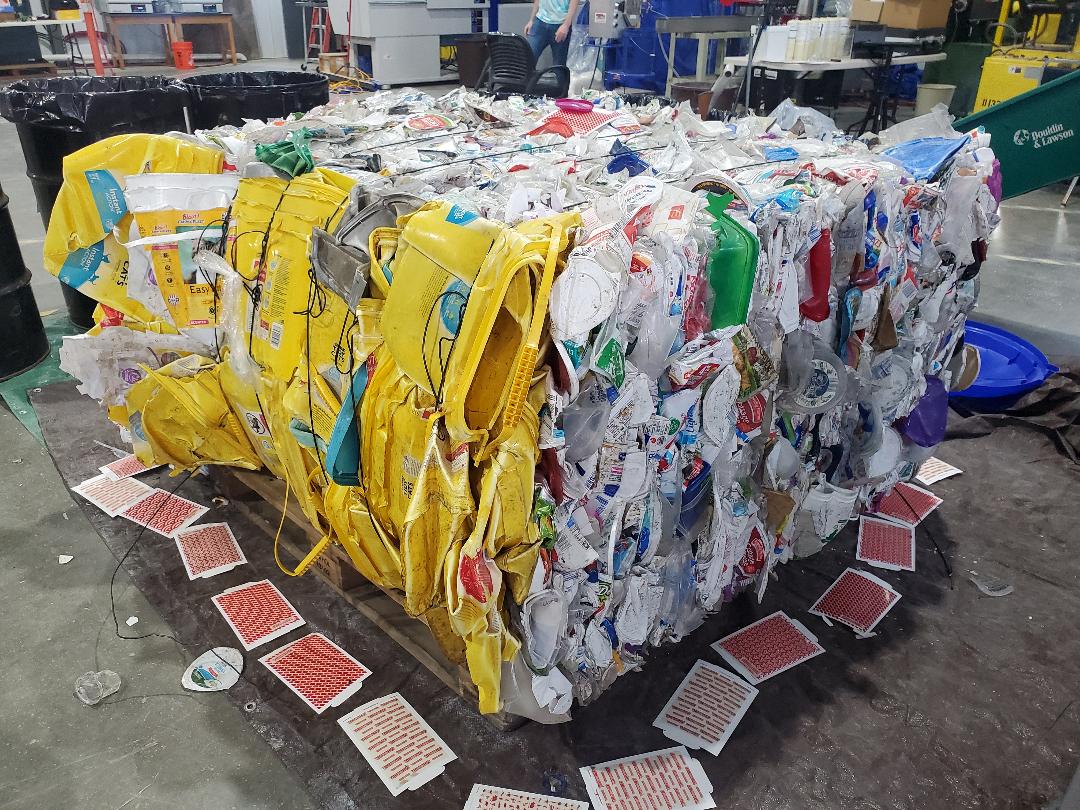Composition, and Potential, of Waste Plastics

Iowa State University project dissects the contents of bales acquired from different recycling facilities
Not all plastics waste is created equal.
Victor Sanfins Cecon is committed to demonstrating just how different it can be, with the aim of improving recycling. Cecon highlighted his research in a talk during one of the sustainability sessions at ANTEC.
With plastics production continuing to grow, it’s essential that recycling become more efficient and effective.
“One essential approach to increase recycling rates is to evaluate the composition of outbound streams from current recycling facilities and what capacity they can be reused,” said Cecon, who received his bachelor’s degree in chemical engineering in Brazil in 2019 and is pursuing a PhD in food science and technology at Iowa State University in Ames.
In his latest study, Cecon assessed the composition and quality of outbound bales containing No. 3 to 7 plastics that were destined for landfill or waste-to-energy facilities, to better understand the potential to increase recycling rates. He sourced the 700-pound bales from three material recovery facilities (MRFs) in Iowa and Wisconsin and he and his team of students invested more than 600 man-hours to manually sort and analyze them using multiple plastic characterization techniques.
He found significant differences in bale composition between MRFs. The changes usually were associated with the sophistication level or technology used in the sorting process with seasonal feedstock variability.
Polyethylene terephthalate (PET) and (high-density polyethylene (HDPE) are the most desired, with 17.2 percent and 8.9 percent, respectively, of those resins being recycled from municipal solid waste streams, according to the U.S. Environmental Protection Agency. By comparison, only 8.5 percent of all plastics being generated are recycled, with the popular polypropylene (PP) packaging resin recycled at a paltry rate of only 0.6 percent, the data show.
Using traditional mechanical recycling processes, his team sorted, cleaned and processed the materials extracted from the bales, ground them into flakes and then washed, extruded and injection molded them into “dog bone” samples for mechanical testing. When visual sorting was not possible, they used the non-destructive ATR-FTIR (Attenuated Total Reflection Fourier Transform Infrared) spectroscopy technique to identify the resins. They then did physical, thermal and molecular characterization of all the recovered PET, HDPE, low-density PE, PP and polystyrene resins.
“Despite the differences in composition, some polymer properties presented similar values across MRFs,” Cecon said. “This research suggests that landfill-diverted mixed plastic waste can be utilized for novel and advanced recycling operations to recover unrecycled materials, as processes can be designed to provide consistent polymer properties. This research also suggests the need for upgrading the sorting systems to prevent waste feedstocks that can be recycled with current technologies from ending up with low-value products or at landfills.”
The researchers used a variety of resin characterization technologies, such as thermogravimetric analysis, differential scanning calorimetry and gel permeation chromatography, to assess the recovered materials.
Cecon noted that PP was the main plastic in all the bales, regardless of MRF, though the volumes varied based on the collection location. He found the composition of the waste plastic bales differed depending on whether they were collected in suburban, urban or rural settings.
Polypropylene dominated (78 percent or more) in the bales from the suburban and rural MRFs, but comprised less than 43 percent in the urban waste, which saw much greater amounts of PET (20 percent) than the others. This, he said, was possibly due to less efficient or older sorting equipment at the MRF.
This indicates, Cecon suggested, that it would be fruitful to improve sorting capabilities for PP resin, and to improve the removal of PET and HDPE from the waste stream. Increasing the availability of recycled PP would help companies to meet recent legislation (e.g., in California, Washington and New Jersey) requiring a minimal content of post-consumer recycled plastic in new packaging products. Increasing the amount of PET and HDPE recovered would boost profit margins of the MRFs, as those reclaimed materials can be sold in their respective plastic bale types.
Some differences in thermal properties of the recovered plastic were minimal, while the melt flow and mechanical properties for the material from the rural MRFs differed significantly compared to those of urban and suburban bales.
For the next steps, he said it will be important to identify contaminants of concern, such as phthalates or perfluoroalkyl and polyfluoroalkyl substances, and to differentiate by grade and process application (such as for extrusion blow molding or injection molding). Finally, Cecon wants to be able to determine the suitability of the recovered material for advanced recycling, such as pyrolysis.
Overall, Cecon’s study suggests there is a considerable amount of PP that can be used for mechanical recycling and much of it is not being recovered. By separating this plastic into a single bale type, there is the potential to increase profits and recycling rates, especially as legislation requiring the use of post-consumer recycled plastic in packaging begins to take effect, leading to a surge in demand. Nonetheless, upgrades in the plastic waste management infrastructure may be necessary to reduce contamination and provide plastic bales of high quality and consistent properties.
Cecon noted that this material is based on work supported by the U.S. Department of Energy, Office of Energy Efficiency and Renewable Energy, Bioenergy Technologies Office under Award Number DE-EE0009285. This work was also partly supported by the Polymer and Food Protection Consortium at Iowa State University and the Agriculture and Home Economics Experiment Station HATCH Project 04202.
